8 de November de 2023
Squat Velocity: Discover the Right Speed for Your Training
The squat is one of the most important exercises for strengthening the muscles of the lower extremities. To achieve optimal performance with this fundamental exercise, it’s crucial to consider the speed and type of muscle contraction, as they impact muscle activation, strength, and power (Lee & Lee, 2018). In this article, we’ll delve into squat speed from the most general aspects to the more specific: the pace of each repetition, squat speed measured with a specialized device like the Virtue encoder, and the significance of squat speed loss for prescribing training in the most individualized manner possible.
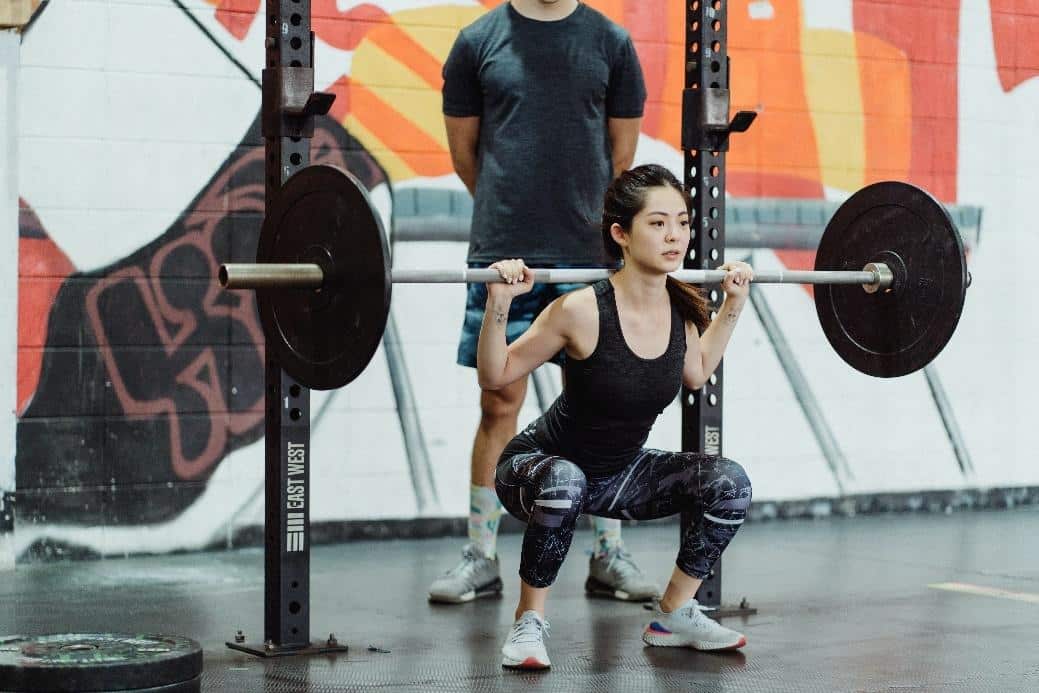
Squat Velocity for Lower Body Muscular Hypertrophy
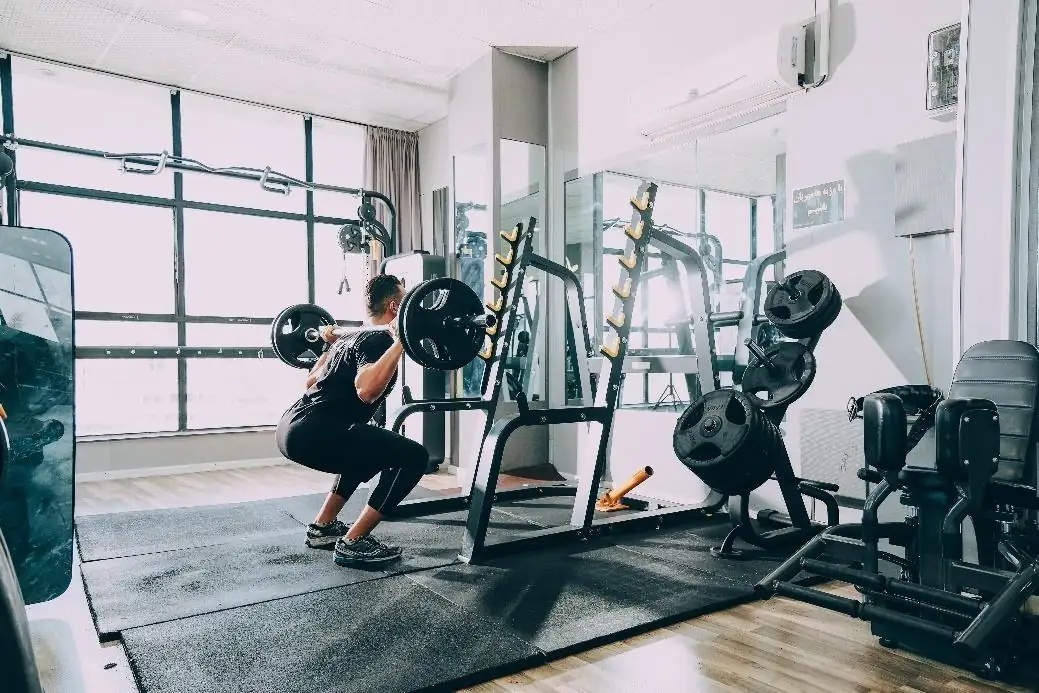
Strength training incorporates various methods to enhance muscle hypertrophy, strength, and power. This is why many people don’t distinguish between the training methods for these aspects, grouping them all together. While there are many similarities between the three, for muscle hypertrophy, we must handle training variables differently than for developing strength or power. One such variable is the speed of each repetition, which, while not having limited importance for muscle hypertrophy, becomes increasingly crucial for strength and even more so for power.
A slow squat speed leads to significant changes in the thickness of muscle groups like the quadriceps, but it achieves little effect on power production in dynamic explosive movements (Usui et al., 2016). Slow squat speed can improve lower body strength, but as we’ll see in the next section, intentional slow squat speed is different from unintentional slow squat speed.
Scientific literature has shown that squat speed can be executed at different tempos, yielding similar improvements in muscle mass gains (Schoenfeld et al., 2015). In the case of muscle hypertrophy, the mechanical tension obtained through a combination of the load on the bar and time under tension (TUT) is more important than whether the squat speed is faster or slower (Burd et al., 2012; Wilk et al., 2020). Various researchers have demonstrated this, leading to the following conclusion: if our goal is to gain muscle mass, we can perform repetitions faster or slower, as long as it’s not excessively slow. Taking more than 8 seconds per repetition could potentially negatively impact hypertrophic adaptations (Wilk et al., 2020).
Squat Tempo for Muscle Hypertrophy Training
- So far, we’ve established that squat speed can vary if our goal is to gain muscle mass because the gains are similar, except when the squat speed is excessively slow (more than eight seconds per repetition). Within the range of one to eight seconds, we have flexibility in our approach. There’s a general recommendation expressed with digits like 3/1/1/1 or 3/0/1/0:
- The first digit (3) suggests that the recommended eccentric phase should last about three seconds. During the descent, the squat speed should take approximately three seconds until reaching the lowest point.
- The second and fourth digits (1 or 0) refer to the transition or isometric phase. This phase occurs between the descent and ascent and between the ascent and descent. You can take one second between the descent and ascent or skip it—this depends on your sensations with the exercise or whether you aim to eliminate the stretch-shortening cycle.
- The third digit describes squat speed during the ascent, the concentric phase. While this phase can be somewhat more explosive or slower, a duration of one second may be most advisable.
Squat Speed for Gaining Muscle Strength and Power

Research indicates that fast squat speed has shown significant positive differences in strength, power gains, and balance (Lee & Lee, 2018). In sports actions like sprinting, jumping, changing direction, etc., we need to apply maximum force in minimal time, often as brief as 0.1 – 0.2 seconds (Newton et al., 1996; Rhea et al., 2009). This data suggests that performing slow squats makes little sense if our sport demands a high rate of force development. In explosive movements like sprinting, jumping, and changing direction, force is much less critical than the rate of force development.
An athlete may possess high levels of strength but may struggle to apply that force rapidly (Rhea et al., 2009). This brings us to the question of what squat speed we should train, and the answer, as often in such cases, is “it depends.” Specificity is a fundamental training principle that involves training according to the requirements of our sport. A powerlifter needs to lift the maximum weight in the squat, but time is not a limiting factor. In contrast, a basketball player needs to jump as high as possible to block an opponent’s shot, requiring the application of maximum force in minimal time.
Training slow squats may generate adverse effects on power production (Aagaard, 2003; Behm & Sale, 1993). In other words, training slowly may lead to deterioration rather than improvement. The eccentric phase of the squat (the descent) can be somewhat slower to control the movement, as this phase doesn’t need to be fast or explosive to gain strength and power. However, the concentric phase of the squat (the ascent) should not exceed two seconds or be intentionally slow, as this may result in lower gains in strength and, especially, power (Hermes & Fry, 2023).
Squat Tempo for Training to Gain Muscle Strength and Power
- So far, we’ve seen that the speed of the squat can vary depending on the goal, being faster or slower if we aim for muscle mass gains since the results are similar, except for very slow speeds (over eight seconds per repetition). In contrast, if the goal is to develop muscle strength or power, squat speed must be handled with greater attention, as it makes a significant difference. A general recommendation is presented with the digit sequence 2 / 0 / 1 / 0 or 2 / 0 / X / 1:
- First digit (2): Controlling the load in the eccentric phase (descent). Too slow a speed in this phase can be dangerous and affect the following concentric phase by requiring a sudden load brake. Over two seconds can generate unnecessary fatigue, although, if it contributes to muscle development, it will also positively impact maximum strength.
- Second and fourth digits (1 or 0): Indicates that we don’t pause in the transition phase or do so very briefly to breathe and prepare for the next repetition. When dealing with a heavy load, every second counts, and spending time in these phases is not a good idea.
- Third digit (1 or ‘X’): Indicates that we should move the load quickly or at the maximum intentional speed possible, a vital aspect for sports performance and power.
Squat Velocity: VBT as the Most Effective Method to Determine How Fast We Move
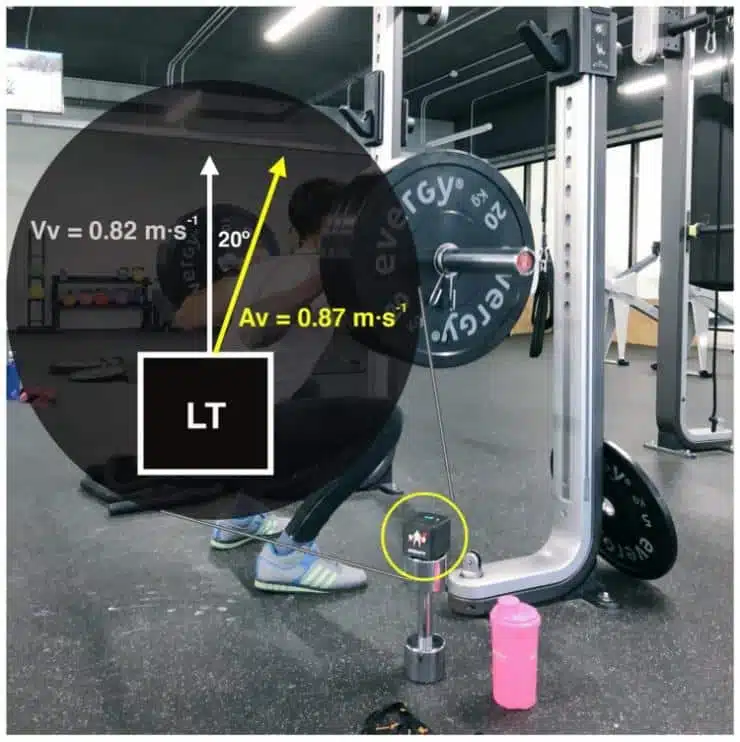
Velocity and strength stand out as two highly sought-after physical qualities in athletic performance. Often, these qualities are trained independently, but in reality, they are interconnected (Rhea et al., 2009). The amount of force an athlete can apply to the ground determines how fast they can run, how effectively they can change direction, and how high they can jump—actions predominant in many athletic activities.
Velocity-based strength training (VBT) aims to provide a precise squat speed for each repetition, as well as the speed below which we will fail the lift (Włodarczyk et al., 2021). To determine the speed of each squat repetition, devices like the Vitruve encoder exist, providing real-time data during the lift. With each repetition, we obtain the speed at which we moved the bar, and this data can be associated with a percentage of the maximum load we can lift.
An example of the growing scientific evidence is the table below, associating a percentage of one-repetition maximum (% 1RM) with the speed at which we can move each weight (Muñoz de la Cruz et al., 2023). A crucial detail in velocity-based strength training is that we should always move the load at the maximum intentional speed, regardless of the weight. A heavier weight won’t allow for high speed, but our intention, regardless of external appearance, is to move those kilos on the bar as fast as possible.
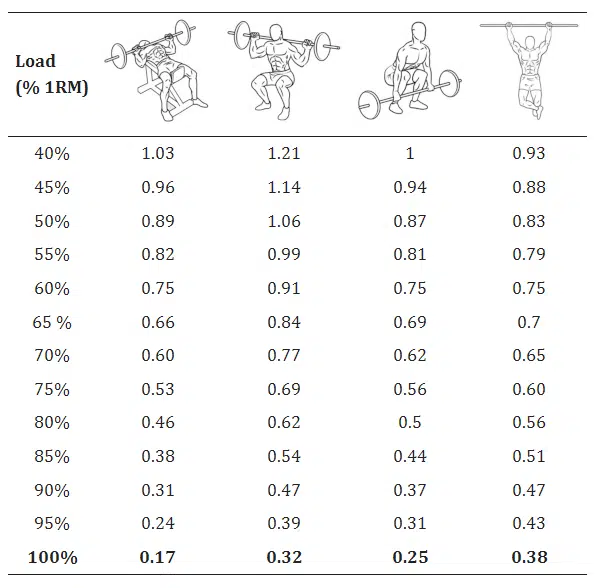
The table above illustrates the relationship between load and speed in exercises such as the bench press, squat, deadlift, and pull-ups. For squat velocity, we can observe how a 90% load will be moved at around 0.47 m/s, on average. Ideally, designing a similar table with the individual characteristics of our athlete is recommended, as they may vary from the data in this table extracted from various studies (Benavides-Ubric et al., 2020; Conceição et al., 2016; González-Badillo & Sánchez-Medina, 2010; Sánchez-Medina et al., 2014).
Depending on our athletic goal, we should train at a higher or lower speed, considering speed zones and speed loss (Włodarczyk et al., 2021). When monitoring our athlete’s performance, familiarity with the force-velocity curve is essential. This curve relates loads to the speeds at which these loads can be moved. The greater the load, the lower the speed, and vice versa. The squat velocity will depend on what we aim to improve in our athlete.
For a powerlifter, who needs to lift the maximum weight even if the speed is minimal, we would train at a low squat speed, potentially in a zone of 0.5 meters per second. According to the previously presented table, a speed of 0.5 m/s corresponds to a load between 85% and 90%. However, enriching a powerlifter’s sessions involves training at all possible speeds, including higher speeds with lighter loads. Specific recommendations are challenging due to variations in sports and athlete conditions.
Athletes in sports like volleyball or American football, involving actions such as jumping and quick direction changes, may need to move lighter loads (body weight) at maximum speed. The squat velocity for training could be higher, in a zone around 1 m/s, corresponding to loads of approximately 50% – 55% of their maximum squat weight. Similar to powerlifters, these athletes also benefit from training across the entire force-velocity curve. Refer to our previous article explaining how to optimize strength training based on athletes’ force-velocity curve to explore the four squat velocity options for training.
- Slow Squats with Heavy Load: Involves lifting very heavy loads, even when intentionally moving slowly.
- Moderate-Speed Squats with Moderate Load: In this approach, squats are moderately heavy, allowing for slightly higher speed but still at a slow pace.
- High-Speed Squats with Low Load: Prioritizing speed overload, this technique involves squats with low resistance, facilitating greater speed, even incorporating jumps.
- Very High-Speed Squats with Minimal Load: Leveraging external assistance like elastic bands, this method allows squatting at speeds surpassing individual capabilities, reaching supramaximal squat speed.
What Squat Velocity Loss Can I Afford to Maximize Training Benefits?

Controlling squat speed, whether in general (slow or fast) or specific (a precise speed value in meters per second), adds a quality edge to our training sessions. With a speed-measuring device like Vitruve, we can take it a step further: managing squat speed loss. We’ve previously observed how squat speed decreases with higher loads. This speed also slows down as we accumulate more repetitions. The first repetition is slower than the fourth due to accumulated fatigue. This detail has prompted researchers to explore how we can prescribe squats and any exercise based on the speed lost during repetitions and sets. Therefore, understanding execution speed loss allows us to avoid and mitigate undesired fatigue (Sánchez-Medina & González-Badillo, 2011).
Squat Velocity Loss to Manage Fatigue During Training
Several studies compare different velocity losses in fundamental exercises like squats. A recent meta-analysis determined that programming a velocity loss between 20% – 30% from the fastest repetition results in the greatest gains in 1RM (Zhang et al., 2023). Beyond a 30% velocity loss, the benefit-fatigue relationship starts exponentially leaning toward fatigue. Therefore, we should avoid reaching such velocity losses unless aiming for high fatigue for a specific reason.
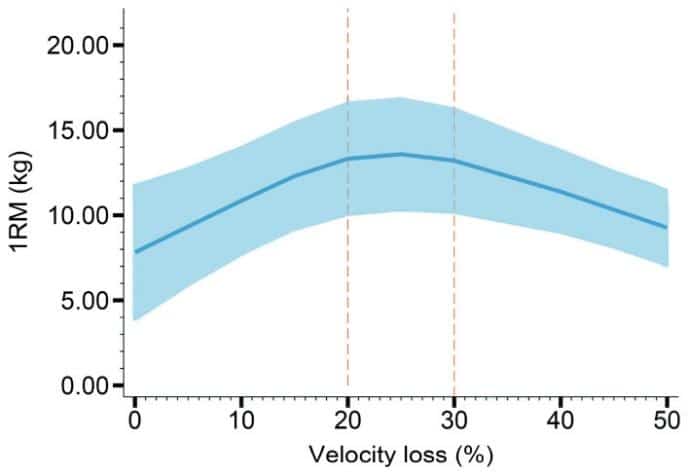
We can even fine-tune squat velocity loss programming based on the load used (Jukic et al., 2023; Pareja-Blanco et al., 2020; Walker et al., 2022; Zhang et al., 2023):
Between 75-100% of 1RM, a velocity loss of 20-30%
Between 70-85% of 1RM, a velocity loss of 20%
Between 50-75% of 1RM, a velocity loss of 10-20%
Between 50-70% of 1RM, a velocity loss of 15%
Below 50%, a velocity loss of 5-10%
Research specifically assessing squat velocity loss has concluded that we should perform half of the possible repetitions plus/minus two within the same set (Jidovtseff et al., 2011; Pareja-Blanco et al., 2014). The ‘no pain, no gain’ mindset has led us to believe that more effort translates to greater gains, but that’s not the case. We prefer the ‘no brain, no gain’ culture because greater strength and power gains can be achieved with squats by doing fewer repetitions with less fatigue.
One group of athletes trained with a 20% velocity loss in the squat, while another group trained with a 40% velocity loss. Obviously, the 20% velocity loss group did fewer repetitions and shorter workouts than the 40% group. The result shows that a lower squat velocity loss produces the same strength improvement and even greater gains in vertical jump (Walker et al., 2022). Therefore, squat velocity loss should be low, around a maximum of 20%, translating to doing half of the possible repetitions plus/minus two.
References
Aagaard, P. (2003). Training-induced changes in neural function. Exercise and Sport Sciences Reviews, 31(2), 61–67. https://doi.org/10.1097/00003677-200304000-00002
Balsalobre-Fernández, C., & Torres-Ronda, L. (2021). The Implementation of Velocity-Based Training Paradigm for Team Sports: Framework, Technologies, Practical Recommendations and Challenges. Sports, 9(4). https://doi.org/10.3390/SPORTS9040047
Behm, D. G., & Sale, D. G. (1993). Velocity specificity of resistance training. Sports Medicine (Auckland, N.Z.), 15(6), 374–388. https://doi.org/10.2165/00007256-199315060-00003
Benavides-Ubric, A., Díez-Fernández, D. M., Rodríguez-Pérez, M. A., Ortega-Becerra, M., & Pareja-Blanco, F. (2020). Analysis of the Load-Velocity Relationship in Deadlift Exercise. Journal of Sports Science & Medicine, 19(3), 452. /pmc/articles/PMC7429441/
Burd, N. A., Andrews, R. J., West, D. W. D., Little, J. P., Cochran, A. J. R., Hector, A. J., Cashaback, J. G. A., Gibala, M. J., Potvin, J. R., Baker, S. K., & Phillips, S. M. (2012). Muscle time under tension during resistance exercise stimulates differential muscle protein sub-fractional synthetic responses in men. The Journal of Physiology, 590(2), 351–362. https://doi.org/10.1113/JPHYSIOL.2011.221200
Conceição, F., Fernandes, J., Lewis, M., Gonzaléz-Badillo, J. J., & Jimenéz-Reyes, P. (2016). Movement velocity as a measure of exercise intensity in three lower limb exercises. Journal of Sports Sciences, 34(12), 1099–1106. https://doi.org/10.1080/02640414.2015.1090010
González-Badillo, J. J., & Sánchez-Medina, L. (2010). Movement velocity as a measure of loading intensity in resistance training. International Journal of Sports Medicine, 31(5), 347–352. https://doi.org/10.1055/S-0030-1248333
Hermes, M. J., & Fry, A. C. (2023). Intentionally Slow Concentric Velocity Resistance Exercise and Strength Adaptations: A Meta-Analysis. Journal of Strength and Conditioning Research, 37(8), E470–E484. https://doi.org/10.1519/JSC.0000000000004490
Jidovtseff, B., Harris, N. K., Crielaard, J. M., & Cronin, J. B. (2011). Using the load-velocity relationship for 1RM prediction. Journal of Strength and Conditioning Research, 25(1), 267–270. https://doi.org/10.1519/JSC.0B013E3181B62C5F
Jukic, I., Prnjak, K., King, A., McGuigan, M. R., & Helms, E. R. (2023). Velocity loss is a flawed method for monitoring and prescribing resistance training volume with a free-weight back squat exercise. European Journal of Applied Physiology, 123(6), 1343–1357. https://doi.org/10.1007/S00421-023-05155-X/FIGURES/5
Lee, J. Y., & Lee, D. Y. (2018). Effect of different speeds and ground environment of squat exercises on lower limb muscle activation and balance ability. Technology and Health Care, 26(4), 593–603. https://doi.org/10.3233/THC-181201
Muñoz de la Cruz, V., Agudo-Ortega, A., Sorgente, V., Turner, A. P., & González-Ravé, J. M. (2023). The effectiveness of adjusting resistance training loads through velocity-based techniques in experienced sprinters: a case series study. Frontiers in Physiology, 14. https://doi.org/10.3389/FPHYS.2023.1241459
Newton, R. U., Kraemer, W. J., Häkkinen, K., Humphries, B. J., & Murphy, A. J. (1996). Kinematics, Kinetics, and Muscle Activation during Explosive Upper Body Movements. Journal of Applied Biomechanics, 12(1), 31–43. https://doi.org/10.1123/JAB.12.1.31
Pareja-Blanco, F., Alcazar, J., Sánchez-Valdepeñas, J., Cornejo-Daza, P. J., Piqueras-Sanchiz, F., Mora-Vela, R., Sánchez-Moreno, M., Bachero-Mena, B., Ortega-Becerra, M., & Alegre, L. M. (2020). Velocity Loss as a Critical Variable Determining the Adaptations to Strength Training. Medicine and Science in Sports and Exercise, 52(8), 1752–1762. https://doi.org/10.1249/MSS.0000000000002295
Pareja-Blanco, F., Rodríguez-Rosell, D., Sánchez-Medina, L., Gorostiaga, E. M., & González-Badillo, J. J. (2014). Effect of movement velocity during resistance training on neuromuscular performance. International Journal of Sports Medicine, 35(11), 916–924. https://doi.org/10.1055/S-0033-1363985
Rhea, M. R., Kenn, J. G., & Dermody, B. M. (2009). Alterations in speed of squat movement and the use of accommodated resistance among college athletes training for power. Journal of Strength and Conditioning Research / National Strength & Conditioning Association, 23(9), 2645–2650. https://doi.org/10.1519/JSC.0B013E3181B3E1B6
Sánchez-Medina, L., & González-Badillo, J. J. (2011). Velocity loss as an indicator of neuromuscular fatigue during resistance training. Medicine and Science in Sports and Exercise, 43(9), 1725–1734. https://doi.org/10.1249/MSS.0B013E318213F880
Sánchez-Medina, L., González-Badillo, J. J., Pérez, C. E., & Pallarés, J. G. (2014). Velocity- and power-load relationships of the bench pull vs. bench press exercises. International Journal of Sports Medicine, 35(3), 209–216. https://doi.org/10.1055/S-0033-1351252
Schoenfeld, B. J., Ogborn, D. I., & Krieger, J. W. (2015). Effect of repetition duration during resistance training on muscle hypertrophy: a systematic review and meta-analysis. Sports Medicine (Auckland, N.Z.), 45(4), 577–585. https://doi.org/10.1007/S40279-015-0304-0
Usui, S., Maeo, S., Tayashiki, K., Nakatani, M., & Kanehisa, H. (2016). Low-load Slow Movement Squat Training Increases Muscle Size and Strength but Not Power. International Journal of Sports Medicine, 37(4), 305–312. https://doi.org/10.1055/S-0035-1564255
Walker, S., Häkkinen, K., Virtanen, R., Mane, S., Bachero-Mena, B., & Pareja-Blanco, F. (2022). Acute neuromuscular and hormonal responses to 20 versus 40% velocity loss in males and females before and after 8 weeks of velocity-loss resistance training. Experimental Physiology, 107(9), 1046–1060. https://doi.org/10.1113/EP090371
Wilk, M., Tufano, J. J., & Zajac, A. (2020). The Influence of Movement Tempo on Acute Neuromuscular, Hormonal, and Mechanical Responses to Resistance Exercise-A Mini Review. Journal of Strength and Conditioning Research, 34(8), 2369–2383. https://doi.org/10.1519/JSC.0000000000003636
Włodarczyk, M., Adamus, P., Zieliński, J., & Kantanista, A. (2021). Effects of Velocity-Based Training on Strength and Power in Elite Athletes—A Systematic Review. International Journal of Environmental Research and Public Health, 18(10). https://doi.org/10.3390/IJERPH18105257
Zhang, X., Feng, S., & Li, H. (2023). The Effect of Velocity Loss on Strength Development and Related Training Efficiency: A Dose–Response Meta–Analysis. Healthcare, 11(3). https://doi.org/10.3390/HEALTHCARE11030337

